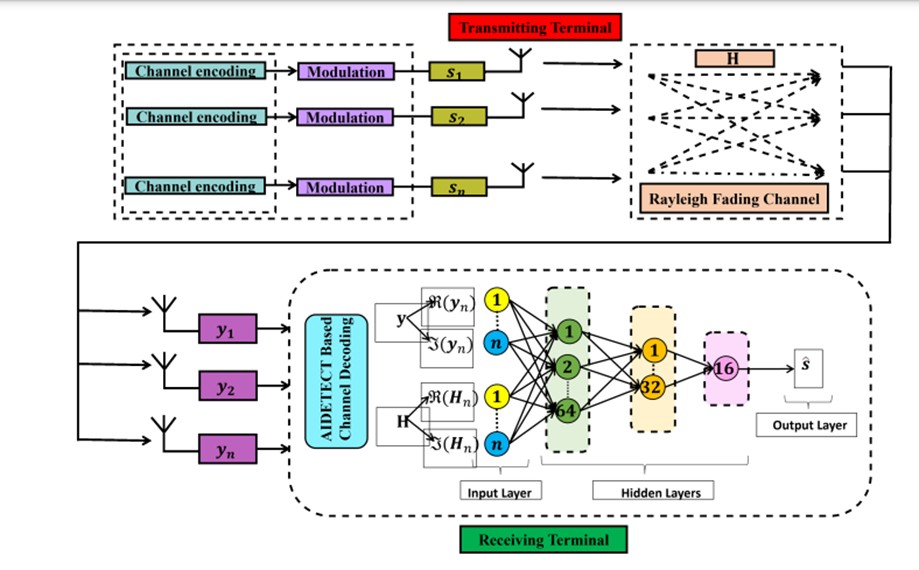



As mobile technology advances, the demand for faster, more reliable communication systems is rapidly growing. By the end of 2025, the number of mobile users worldwide is expected to reach an astounding 7.49 billion. To meet the rising demand for mobile data rates, Multiple Input Multiple Output (MIMO) technology is playing a crucial role in the development of 6G networks.
However, MIMO systems come with their own set of challenges. With multiple antennas used to send and receive data, interference can occur, making it harder to correctly receive and process all signals. To address this, researchers are turning to artificial intelligence (AI), which can help detect signals more accurately and efficiently, even in the presence of interference.

The Problem with Traditional Signal Detection
MIMO systems use multiple antennas to transmit data, which increases the system’s data capacity. However, the interference from different signals makes accurate detection of the transmitted data challenging. Traditional detection methods like MMSE (Minimum Mean Square Error) and Zero-Forcing (ZF) help, but they struggle under high interference and become computationally expensive as systems grow larger.
With the increasing complexity of MIMO systems, these methods limit overall system efficiency. That’s where AI-based deep learning (DL) models come in. These models learn from data to improve signal detection performance, but even AI-based methods can suffer from high computational costs. So, the challenge is to improve AI models in terms of both performance and efficiency.
The Solution: AIDETECT – An Optimized AI-Based Signal Detection Method
The answer to these challenges lies in AIDETECT, an AI-based signal detection method designed for MIMO systems. Unlike traditional methods, AIDETECT uses a lightweight deep neural network (DNN) architecture, which makes it both faster and more efficient while maintaining high accuracy.
A key feature of AIDETECT is its optimized training process, which tailors the system to specific signal conditions. This allows AIDETECT to outperform traditional MIMO detectors without putting a heavy computational load on the system. In simpler terms, AIDETECT can detect signals more accurately and with less effort than older methods, making it ideal for the high-speed, high-demand 6G networks.
How AIDETECT Works
AIDETECT is trained on data that includes transmitted signals, channel information, and noise. Using this data, it estimates the signal that the receiver would get in the presence of interference. It then extracts the original transmitted data, even with the noise present.
Simulations have shown that AIDETECT achieves up to 99.99% better performance than conventional MIMO detectors and between 25% to 99.98% better performance compared to other AI-based detectors. This means that AIDETECT offers a significant improvement in detection accuracy, making it a strong candidate for future 6G networks.
To better evaluate signal detection performance, a new metric called Vector Error Rate (VER) was introduced alongside traditional metrics like Symbol Error Rate (SER) and Bit Error Rate (BER). VER provides a more detailed view of how well the system is detecting signals, especially in complex environments with interference.

Why AIDETECT is a Game-Changer for 6G
The real strength of AIDETECT lies in its ability to reduce computational complexity without sacrificing performance. As mobile networks grow and become more complex, traditional detection methods will struggle to keep up. AIDETECT’s lightweight architecture ensures it can handle large-scale MIMO systems efficiently, making it ideal for real-time applications in 6G networks.
When compared to traditional methods and other AI-based systems like DetNet, OAMP-Net-2, and LISA, AIDETECT consistently shows superior performance, making it a strong contender for 6G network deployments.
Conclusion: The Future of 6G Networks
As 6G networks emerge, the demand for faster, more efficient communication will only increase. AIDETECT represents a major breakthrough in optimizing MIMO systems, offering a solution that meets the growing demand for mobile data rates without overburdening the system. With its ability to reduce complexity and improve performance, AIDETECT is paving the way for the high-speed, high-capacity 6G networks of the future.
This research is by Dr. Kiran Khurshid and her collaborators at National University of Science and Technology (NUST), Pakistan, and Ulster University, UK.
The author is an Assistant Professor at the Department of Computer and Software Engineering, College of Electrical and Mechanical Engineering, National University of Science and Technology (NUST). She can be reached at kiran.khurshid@ceme.nust.edu.pk.
Research Profile: https://bit.ly/3ZPpynv

![]()




